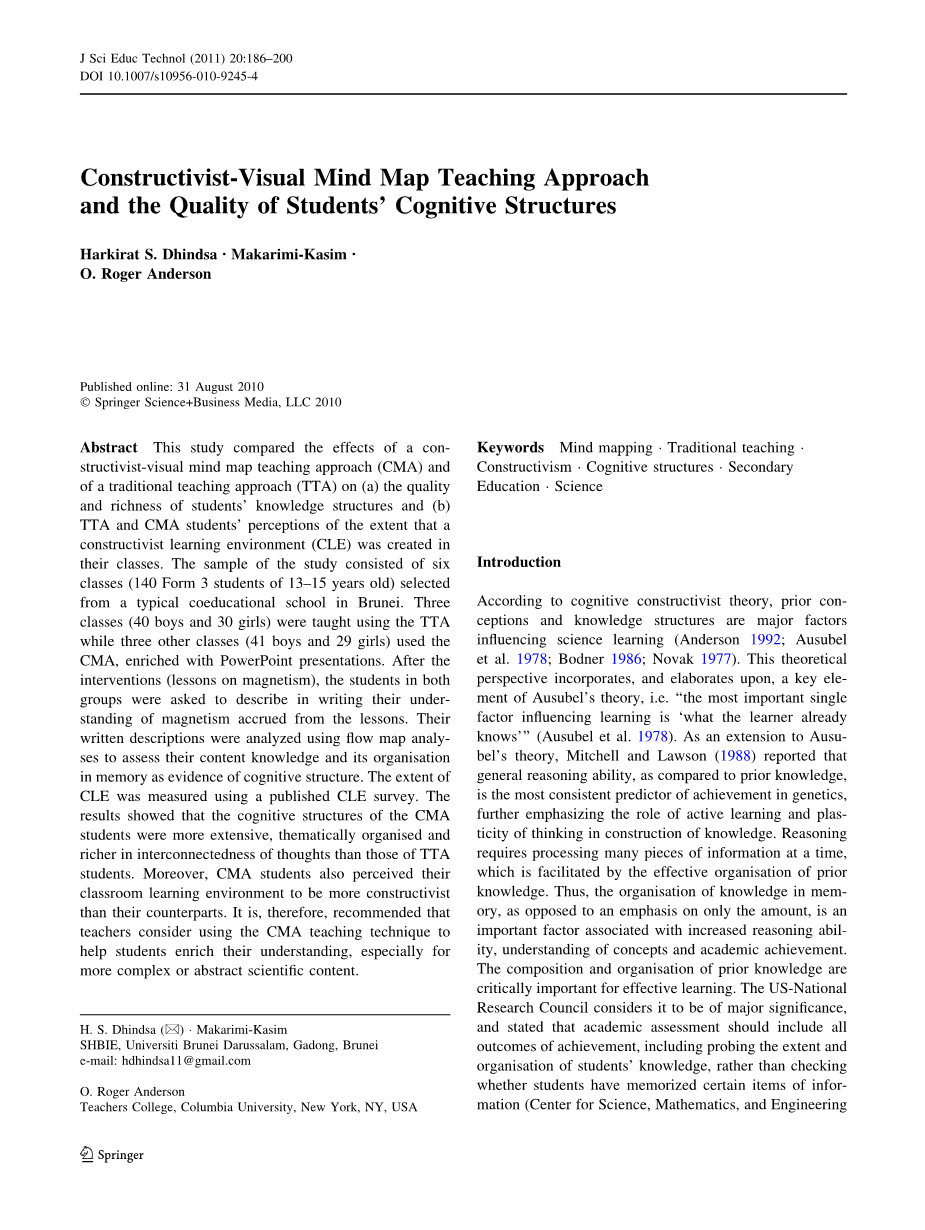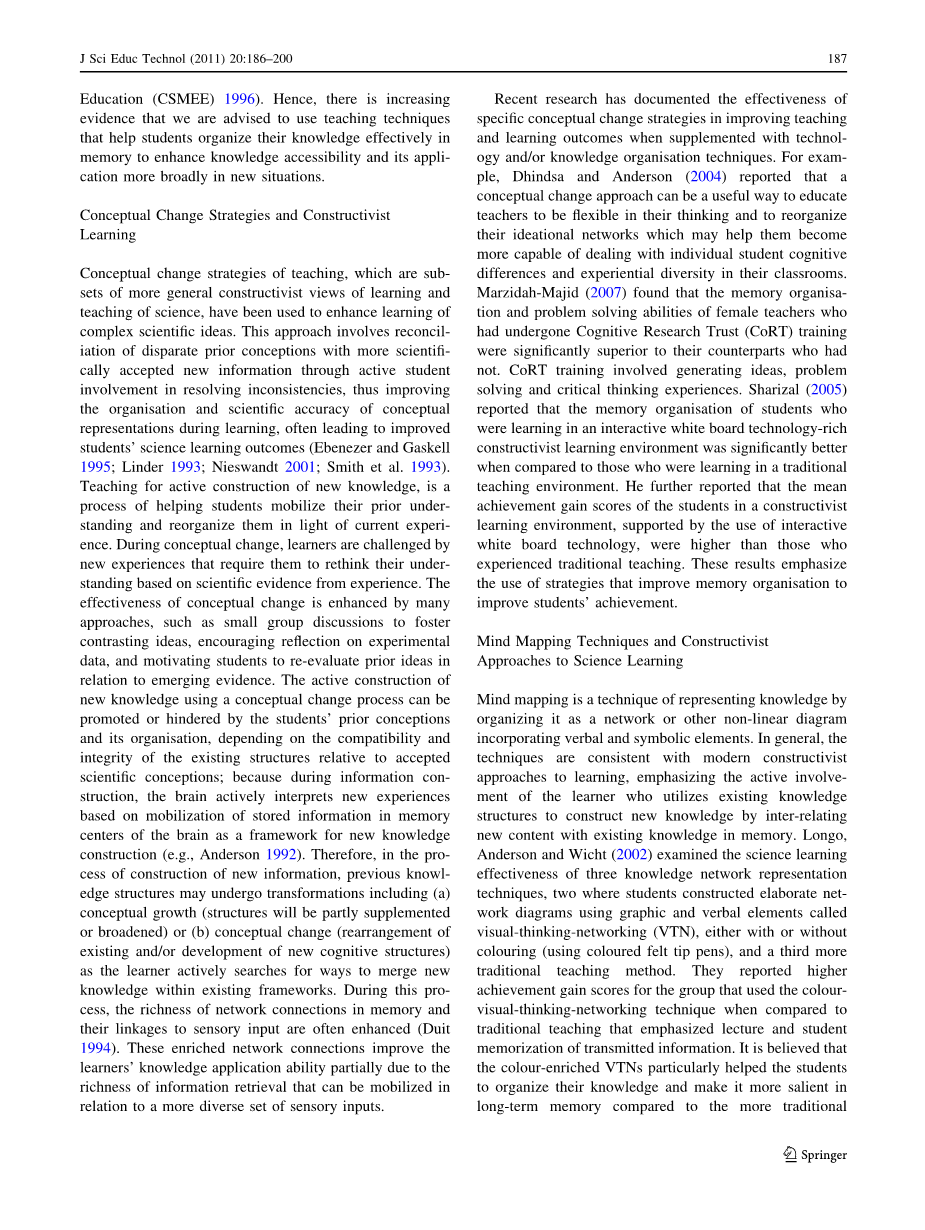本科毕业设计(论文)
外文翻译
Constructivist-Visual Mind Map Teaching Approach and the Quality of Studentsrsquo; Cognitive Structures
作者:Harkirat S. Dhindsa
国籍:America
出处:Journal of Science Education and Technology, 2010, 20(2): 186-200.
Abstract
This study compared the effects of a constructivist-visual mind map teaching approach (CMA) and of a traditional teaching approach (TTA) on (a) the quality and richness of studentsrsquo; knowledge structures and (b) TTA and CMA studentsrsquo; perceptions of the extent that a constructivist learning environment (CLE) was created in their classes. The sample of the study consisted of six classes (140 Form 3 students of 13–15 years old) selected from a typical coeducational school in Brunei. Three classes (40 boys and 30 girls) were taught using the TTA while three other classes (41 boys and 29 girls) used the CMA, enriched with PowerPoint presentations. After the interventions (lessons on magnetism), the students in both groups were asked to describe in writing their under- standing of magnetism accrued from the lessons. Their written descriptions were analyzed using flow map analyses to assess their content knowledge and its organisation in memory as evidence of cognitive structure. The extent of CLE was measured using a published CLE survey. The results showed that the cognitive structures of the CMA students were more extensive, thematically organised and richer in interconnectedness of thoughts than those of TTA students. Moreover, CMA students also perceived their classroom learning environment to be more constructivist than their counterparts. It is, therefore, recommended that teachers consider using the CMA teaching technique to help students enrich their understanding, especially for more complex or abstract scientific content.
Introduction
According to cognitive constructivist theory, prior conceptions and knowledge structures are major factors influencing science learning (Anderson 1992; Ausubel et al. 1978; Bodner 1986; Novak 1977). This theoretical perspective incorporates, and elaborates upon, a key element of Ausubelrsquo;s theory, i.e. lsquo;lsquo;the most important single factor influencing learning is lsquo;what the learner already knowsrsquo;rsquo;rsquo; (Ausubel et al. 1978). As an extension to Ausubelrsquo;s theory, Mitchell and Lawson (1988) reported that general reasoning ability, as compared to prior knowledge, is the most consistent predictor of achievement in genetics, further emphasizing the role of active learning and plasticity of thinking in construction of knowledge. Reasoning requires processing many pieces of information at a time, which is facilitated by the effective organisation of prior knowledge. Thus, the organisation of knowledge in memory, as opposed to an emphasis on only the amount, is an important factor associated with increased reasoning ability, understanding of concepts and academic achievement. The composition and organisation of prior knowledge are critically important for effective learning. The US-National Research Council considers it to be of major significance, and stated that academic assessment should include all outcomes of achievement, including probing the extent and organisation of studentsrsquo; knowledge, rather than checking whether students have memorized certain items of information (Center for Science, Mathematics, and Engineering Education (CSMEE) 1996). Hence, there is increasing evidence that we are advised to use teaching techniques that help students organize their knowledge effectively in memory to enhance knowledge accessibility and its application more broadly in new situations.
Conceptual Change Strategies and Constructivist Learning
Conceptual change strategies of teaching, which are sub- sets of more general constructivist views of learning and teaching of science, have been used to enhance learning of complex scientific ideas. This approach involves reconciliation of disparate prior conceptions with more scientifically accepted new information through active student involvement in resolving inconsistencies, thus improving the organisation and scientific accuracy of conceptual representations during learning, often leading to improved studentsrsquo; science learning outcomes (Ebenezer and Gaskell 1995; Linder 1993; Nieswandt 2001; Smith et al. 1993). Teaching for active construction of new knowledge, is a process of helping students mobilize their prior under- standing and reorganize them in light of current experience. During conceptual change, learners are challenged by new experiences that require them to rethink their under- standing based on scientific evidence from experience. The effectiveness of conceptual change is enhanced by many approaches, such as small group discussions to foster contrasting ideas, encouraging reflection on experimental data, and motivating students to re-evaluate prior ideas in relation to emerging evidence. The active construction of new knowledge using a conceptual change process can be promoted or hindered by the studentsrsquo; prior conceptions and its organisation, depending on the compatibility and integrity of the existing structures relative to accepted scientific conceptions; because during information construction, the brain actively interprets new experiences based on mobilization of stored information in memory centers of the brain as a framework for new knowledge construction (e.g., Anderson 1992). Therefore, in the process of construction of new information, previous knowledge structures may undergo transformations including (a) conceptual growth (structures will be partly supplemented or broadened) or (b) conceptual change (rearrangement
剩余内容已隐藏,支付完成后下载完整资料


英语原文共 15 页,剩余内容已隐藏,支付完成后下载完整资料
资料编号:[276707],资料为PDF文档或Word文档,PDF文档可免费转换为Word
以上是毕业论文外文翻译,课题毕业论文、任务书、文献综述、开题报告、程序设计、图纸设计等资料可联系客服协助查找。


